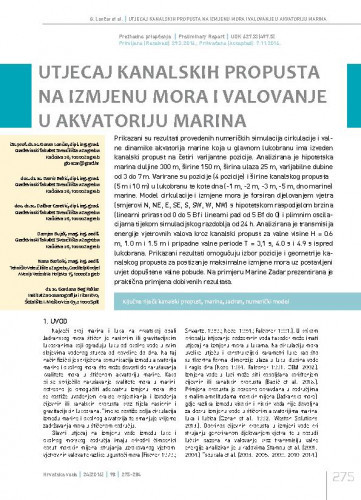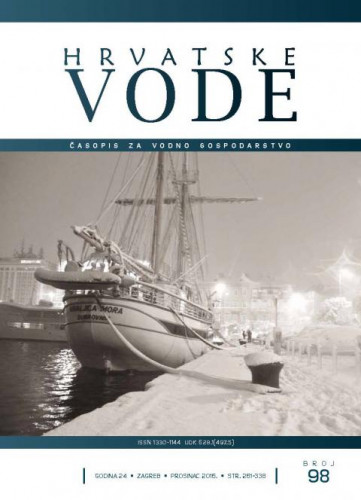Prikazani su rezultati provedenih numeričkih simulacija cirkulacije i valne dinamike akvatorija marine koja u glavnom lukobranu ima izveden kanalski propust na četiri varijantne pozicije. Analizirana je hipotetska marina duljine 300 m, širine 150 m, širina ulaza 25 m, varijabilne dubine od 3 do 7 m. Varirane su pozicije (4 pozicije) i širine kanalskog propusta (5 m i 10 m) u lukobranu te kote dna (-1 m, -2 m, -3 m, -5 m, dno marine) marine. Model cirkulacije i izmjene mora je forsiran djelovanjem vjetra (smjerovi N, NE, E, SE, S, SW, W, NW) s hipotetskom raspodjelom brzina (linearni prirast od 0 do 5 Bf i linearni pad od 5 Bf do 0) i plimnim oscilacijama tijekom simulacijskog razdoblja od 24 h. Analizirana je transmisija energije vjetrovnih valova kroz kanalski propust za valne visine H = 0.6 m, 1.0 m i 1.5 m i pripadne valne periode T = 3,1 s, 4.0 s i 4.9 s ispred lukobrana. Prikazani rezultati omogućuju izbor pozicije i geometrije kanalskog propusta za postizanje maksimalne izmjene mora uz postavljeni uvjet dopuštene valne pobude. Na primjeru Marine Zadar prezentirana je praktična primjena dobivenih rezultata..; The paper presents the results of the conducted numerical simulations of circulation and wave dynamics in the marine waters whose main pier contains a constructed culvert in four variant positions. A hypothetical marina with a length of 300 m, width of 150 m, entrance width of 25 m and variable depths from 3 to 7 m was analysed. The culvert positions (4) and widths (5m and 10m) in the pier were varied as well as the seabed elevations (-1 m, -2 m, -3 m, -5 m, marina seabed) of the marina. The model of seawater circulation and exchange was forced by wind action (of N, NE, E, SE, S, SW, W, NW directions) with a hypothetical distribution of velocities (linear increase from 0 to 5 Bf and linear decrease from 5 Bf to 0) and tidal oscillations during the 24-hour simulation period. The transmission of wind wave energy through the culvert was analysed for the wave heights H = 0.6 m, 1.0 m and 1.5 m and associated wave periods T = 3.1 s, 4.0 s and 4.9 before the pier. The presented results facilitate such selection of the position and geometry of the culvert as to achieve the maximal seawater exchange with the set condition of the permitted wave disturbance. The practical application of the obtained results was presented on the example of the Zadar marina.
Sažetak
Dio sveska

